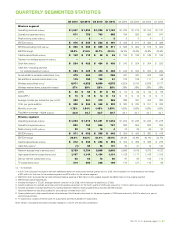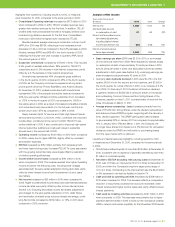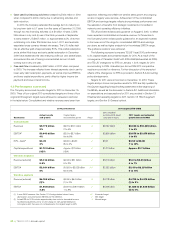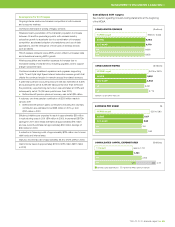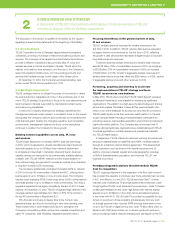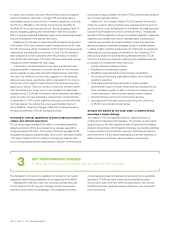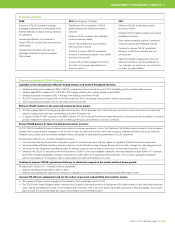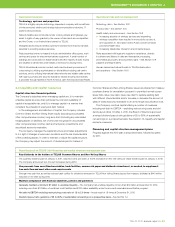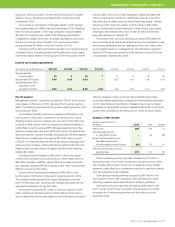Telus 2010 Annual Report Download - page 51
Download and view the complete annual report
Please find page 51 of the 2010 Telus annual report below. You can navigate through the pages in the report by either clicking on the pages listed below, or by using the keyword search tool below to find specific information within the annual report.
TELUS 2010 annual report . 47
Focusing relentlessly on the growth markets of data,
IP and wireless
TELUS’ wireless revenues exceeded its wireline revenues for the
first time in 2010. In addition, TELUS’ wireline data revenue exceeded
its legacy wireline voice revenues for the first time in 2010, reflecting
the growth in data services that has helped mitigate erosion in local and
long distance service revenues.
Combined external wireless revenues and wireline data revenues
were $7.28 billion (74% of consolidated revenue) in 2010, as compared
to $6.85 billion (71% of consolidated revenues) in 2009, an increase
of $429 million or 6.3%. Growth in aggregate wireless revenues and
wireline data revenue more than offset the $256 million, or 9.3%, decline
in aggregate wireline voice and other revenues in 2010.
Partnering, acquiring and divesting to accelerate
the implementation of TELUS’ strategy and focus
TELUS’ resources on core business
In May 2010, TELUS announced that TELUS Health Space®
, powered
by Microsoft HealthVault, was available for licensing by healthcare
organizations. The platform is a high-security data storage and sharing
service that enables Canadians to keep all their personal health infor-
mation in an online database for access over any Internet connection.
TELUS Health Space is the first consumer health platform in Canada
to gain Canada Health Infoway pre-implementation certification for
providing a secure, interoperable application environment and personal
health information platform. The Company also announced that 12
leading national healthcare organizations are collaborating with TELUS
to embed applications, medical devices and educational materials
into TELUS Health Space.
In September, TELUS offered its customers roaming and enhanced
services in Saskatchewan on SaskTel’s new HSPA+ wireless network
through an enhanced network sharing agreement. This development
offers customers, such as those in the natural resources and oil
sectors, improved wireless speeds and wide geographic coverage
of 95% of Saskatchewan’s population, and improves TELUS’ own
business economics.
Providing integrated solutions that differentiate TELUS
from its competitors
TELUS’ ongoing investment in the expansion of its fibre-optic network
has provided the capacity to introduce new home entertainment services
in B.C. and Alberta. In June 2010, TELUS launched OptikTM
, a newly
branded suite of advanced TV and high-speed Internet services. Optik
brings together TELUS’ most advanced home services – Optik TV based
on Microsoft Mediaroom and Optik High Speed with Internet access
speeds of up to 25 Mbps or more that can be accessed anywhere
in the home with Wi-Fi. TELUS Optik TV provides the capability for cus-
tomers to record up to three programs simultaneously from any room
on a single personal video recorder (PVR) and play them back on any
of up to six TVs with a digital set-top box. Optik TV also offers video on
demand with DVD-style controls, an on-screen guide with picture-in-
picture browsing, instant channel changing and call display on the TV.
MANAGEMENT’S DISCUSSION & ANALYSIS: 2
The discussion in this section is qualified in its entirety by the Caution
regarding forward-looking statements at the beginning of the MD&A.
2.1 Core business
TELUS Corporation is one of Canada’s largest telecommunications
companies, providing a full range of telecommunications products and
services. The Company is the largest incumbent telecommunications
provider in Western Canada and also provides data, IP, voice and
wireless services to Central and Eastern Canada. TELUS earns the
majority of its revenue from access to, and the use of, the Company’s
telecommunications infrastructure, or from providing products and
services that facilitate access to and usage of this infrastructure.
At December 31, 2010, the Company’s principal subsidiary was
wholly owned TELUS Communications Inc. (TCI).
2.2 Strategic imperatives
TELUS’ strategic intent is to unleash the power of the Internet to deliver
the best solutions to Canadians at home, in the workplace and on the
move. TELUS’ strategy for growth is to focus on its core telecommunica-
tions business in Canada supported by international contact centre
and outsourcing capabilities.
In 2000, the Company developed six strategic imperatives that
management believes remain relevant. A consistent focus on the impera-
tives guides the Company’s actions and contributes to the achievement
of its financial goals. Despite the changing regulatory and competitive
environments, management believes the focus on the imperatives
continues to position the Company for future growth.
Building national capabilities across data, IP, voice
and wireless
TELUS began deployment of wireless HSPA+ dual-cell technology
in 2010, which is expected to double manufacturer-rated maximum
download speeds to up to 42 Mbps when network deployment
is complete and launched in Canadian cities and towns. Dual-cell
capable devices are expected to be commercially available starting
in March 2011. TELUS’ HSPA+ network and the implementation of
dual-cell technology are expected to provide an optimal future transition
to long-term evolution (LTE) technology.
The Company substantially completed its wireline ADSL2+ network
in 2010 in the top 48 communities in Alberta and B.C., offering down
-
load speeds of up to 15 Mbps or more in some areas. The Company
has also been deploying VDSL2 technology since 2009 to bring network
download speeds of up to 30 Mbps to these communities. The VDSL2
upgrade is expected to be largely complete by the end of 2011 in these
markets. At December 31, 2010, TELUS’ broadband high-definition (HD)
coverage reached approximately two million or 87% of the homes in
the top 48 communities in Alberta and B.C.
TELUS is also continuing to deploy fibre to the home in new
residential areas, and fibre to the building in new multi-dwelling units.
These investments in core infrastructure serve to strengthen the
Company’s competitive position versus other wireless competitors and
cable-TV companies. (See Providing integrated solutions below.)
2CORE BUSINESS AND STRATEGY
A discussion of TELUS’ core business and strategy, including examples of TELUS’
activities in support of its six strategic imperatives


